I've been working on putting a finish on to some pieces to make a router table, so that had to play through at take up valuable workbench space. That project is nearly done, so now its back to the SKS.
At this point I have sent the SKS bolt to Murray's Gunsmithing as nothing, and I do mean nothing, that I can do could get out the firing pin retaining pin, which is necessary to install Murray's firing pin and spring arrangement. If my 3lb. forge hammer can't do it, then the cost of getting a 5lb. sledgehammer is about the same as sending the bolt to get it installed, so off it went to someone who is used to dealing with impossible Yugo SKS bolts.
After that I used my rotary tool to get the retaining rivet on the handguard ground down to where the rivet can be removed. Needless to say the first hit on that with the handguard being well braced and the punch centered on the rivet saw the punch go askew and mess up the ferrule holding the actual handguard in place. Still I got the rivet out and the damage isn't horrific, and it was worth looking around for a replacement.
There aren't any.
Period.
And no one is making replacements for one of the most commonly ruined pieces on an SKS. What I did find was a nice full used handguard with cracked wood from Apex, ferrule and all. That came in so I now have a gas tube spare and a cracked handguard to play around with, after driving a standard pin out of the piece. I am surprised that the ferrule is made of much thicker sheet metal on the spare (Russian I believe) than on the Yugo version. This handguard is heavily used and didn't have much cosmoline on it, and it was cracked all the way through. Just to experiment I did some turpentine cleaning with a nylon cleaning brush to see what could be removed with that.
The untouched half is on the left, the turpentine cleaned on the right. Yes a lot of grime came off pretty easily that way.
Then came the mineral spirit cleaning on the untouched half.
Turpentine cleaned on the left, mineral spirits on the right. Just by what I got off the piece on the right, I can say mineral spirits did an equal or somewhat better job to turpentine. Both good for what grime ails your handguard.
After getting to a stopping point on the play-through work, I stripped the SKS stock to get the old, blackened BLO finish off.
I'm playing around with some color correction and the tonal gradations are more towards the handguard than the butt part of the stock. Note the original handguard piece has also been stripped.
I got this snap of the grip to show the line in the stock at the transition point to the handguard on the center part of the picture in the lower transition. That is seen on both sides of the stock and is either a milling artifact or the grain of the wood exposed by the angle of the wood when it was milled showing up the ring line like that. It is an area I will look at more as I get down to sanding the stock to make sure it isn't an incipient crack.
Sorry about the lack of decent color correction on that, but it was worth not trying to get a good balance to show the growth lines in the wood.
The other side with a bit harsher color correction to bring the current color out. Again the dark line shows up pretty well in the lower transition area of the hand piece.
All of these were taken with halogen lighting which tends to put a really bad color shift into the yellow, which I've tried to balance out via filters and levels. As the lighting falls off the color darkens, naturally.
The underside of the stock.
Close up on the area of concern. I thought that this area still had some finish on it, and it has gotten two doses of the soy stripper. What is left may just be how the grain actually is when smoothed down properly. As that is the area that gets handled the most it may have that coloration due to that.
And looking at the top of the stock.
With the finish removed the stock feels pretty well shaped, thus all the roughness and irregularities were in the finish, not the wood as I had feared. That tells you something about the amount of care (or lack thereof) that was done in the application of the finish.
Next up is a gentle going over with 220, 320 and 400 grit sandpaper, done with the grain. I'm not expecting it to take much sanding, actually, and there are only a few areas of roughness and irregularities that need to be addressed and none are serious. Once that is done I will either use a high solvent tung oil mixture or platina shellac to get a sanding sealer coat on for some bronze wool work to get whiskers. Then a 1:1 tung oil mixture for a first base coat will follow. I haven't really decided if I want to do a traditional finish using BLO or Linspeed after that or layer in a light button lac or orange shellac between tung oil layers. These are decisions I will make when I get to them as I really want something understated and appealing as the growth rings in the wood have a whole lot of 'pop' to them on their own.
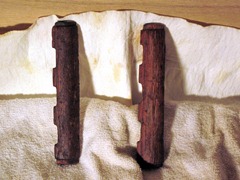

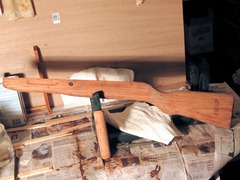
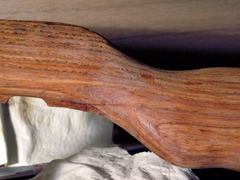


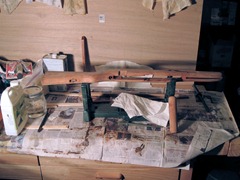
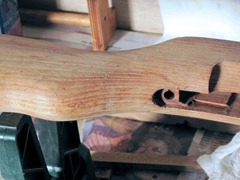
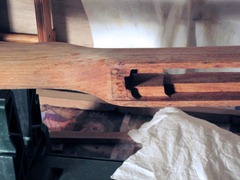
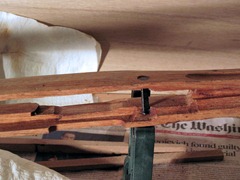




 Supporting Friends and Allies
Supporting Friends and Allies









No comments:
Post a Comment